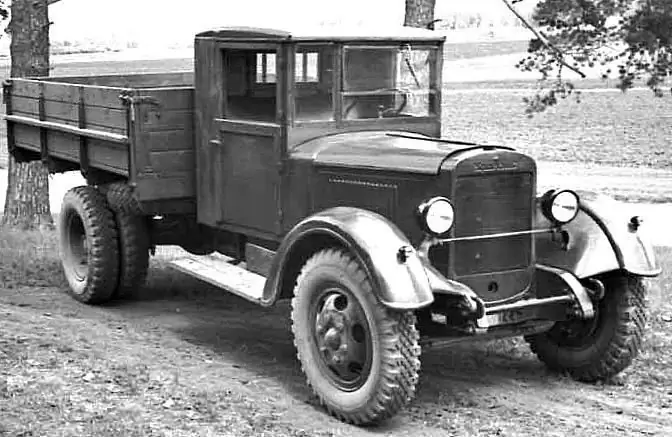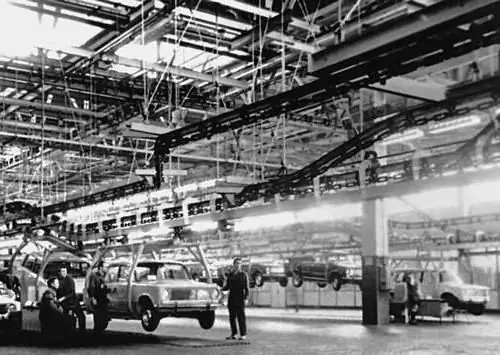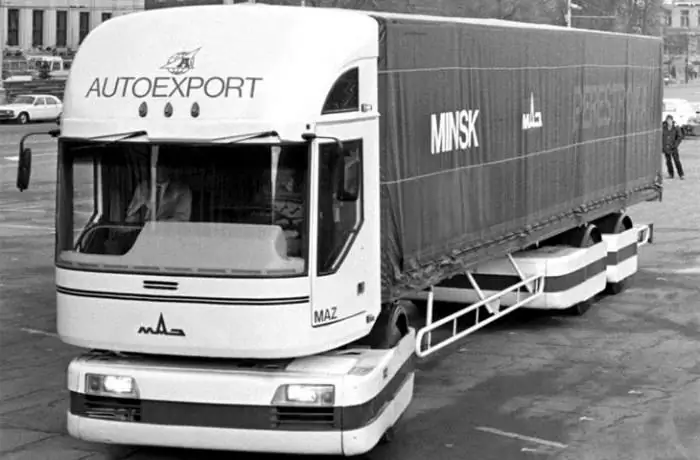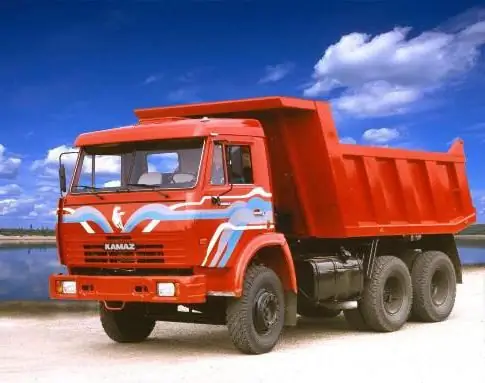2025 Author: Erin Ralphs | [email protected]. Last modified: 2025-01-22 21:14:14
Special attention was paid to the development of mechanical engineering in the USSR. Each plant tried to create a technologically advanced car that would occupy its niche in the country's infrastructure chain. The plant in the city of Kutaisi did not lag behind the general trends and fulfilled the set requirements and tasks. The designers created a truck that became legendary - KAZ-4540.

History of Creation
In 1975, at the request of the State Agricultural Machinery of the USSR, NAMI, together with the State Design Bureau of the city of Balashov, which specialized in the creation of trailers for automobile and tractor equipment, as well as with the Yaroslavl plant, began the development of new equipment. The task was to create a new model of a road train for the needs of agriculture. The truck was supposed to be the missing link, which included collecting crops on the field, loading them, and quickly transporting and unloading them.
In the early 80s, the production of new all-wheel drive road trains was launched on the basis of the Kutaisi plant. The basis for the new model was the prototype NAMI-0215, created from the usual KAZ-608B, with a modernizedundercarriage and two-axle drive.

Before starting mass production and releasing a new truck in the expanses of the former USSR, full-scale tests of samples were carried out. For this, 20 cars were initially created, on which all road and bench tests were carried out. In 1981, tests of a new road train were successfully completed at the NAMI test site. The designers did not stop there and made a number of amendments and changes to individual components and parts of the structure. This was followed by new experiments and regular tests. The new KAZ-4540 had nothing in common with previous models of the Colchis brand.
Already in January 84, when interdepartmental tests were completed, the truck was recommended for production. A month later, the first batch of 500 cars was created.
A truck tractor was also developed on the basis of this truck. He received a new marking - KAZ-4440.
Colchis
This is the name given to the model range of tractors produced by the Kutaisi plant. The first truck left already in August 1951. Most of the components were brought from the Stalin plant. Thanks to the nodes of the Moscow enterprise, dump trucks, small-sized truck tractors, as well as cargo vehicles under the Colchis brand were assembled. The photos of the new specimen were unlike any of the existing ones at that time.
"4540" is a model designed to meet the needs of agriculture. Production continued from 1985 to1998th. During this period, several different modifications of the Colchis truck were created. A distinctive feature of the KAZ-4540 was a bright orange cab with very large windshields.
Destination
Freight transport KAZ-4540, which differed from all other models by two drive axles, was often used in tandem with a GKB-8535 brand trailer. This bundle represented a kind of road train used to transport agricultural products.
Dump truck KAZ-4540 - a universal machine with the ability to unload on three sides. Depending on the specific materials or terrain, one specific method was used. The truck was equipped with all-wheel drive with an optional rear axle differential lock.
The technological design made it possible to use the machine in tandem with combines for harvesting grain crops and cotton. "Colchis" is a vehicle with sufficient cross-country ability required for machinery used in agriculture and a capacity of 11 tons.
In 1990, the designers prepared documentation that would make it possible to equip the car with a refrigerator, use it together with a loading platform, and also create a car for firefighters. Unfortunately, the developments did not receive further development and remained only on paper. "Colchis", the photo of which is presented below, is the most sought-after copy at the time the car was created.

Cab
Cab - cabover, located above the engine. This arrangement allowed for increased maneuverability and the most efficient use of the entire platform. "Colchis" is a car with a short wheelbase and excellent visibility for the driver. The large cabin had a separate seating area, a fan, and a heating stove. All this in total provided a sufficiently high comfort parameter for long and long-distance flights. In 1985, this was a very good indicator.
In 1990, production of an upgraded version began. It was equipped with a hydraulic system to control the opening of the sides. When unloading on any of the working sides, the side was closed automatically.

Power component
The car was equipped with a YaMZ-KAZ-642 diesel engine. The KAZ-4540 engine was mounted behind the wheelbase and worked in tandem with an eight-speed gearshift device (4 available gears and an additional splitter).
The power plant was located directly above the front axle, and all the governing bodies were shifted as far forward as possible. The driver's seat was above the engine. The decision to create such a layout was due to the need to increase the usable area on which the transported materials were located. By increasing the exit angle, the cross-country ability was increased. Such a scheme ensured an even distribution of the load on both axles. The front has 6.12 tons of weight, while the back has 6.14 tons.
Uniform loading allowed the use of single wheels with widetires, and also greatly simplified the pressure control system in the air chambers.
Many innovations were introduced when creating the KAZ-4540. One of these was a disk CV joint, which is more reliable than a spherical counterpart. The maximum speed was 80 km / h, but the carrying capacity was only 6 tons.

Chassis
The running equipment allows the machine to move on heavy dirt roads, as well as on fields after plowing. A transmission with 8 positions was installed on the KAZ-4540 dump truck, providing forward movement, as well as two - back. It was a complex structure, consisting of a 4-speed gearbox and a divider with 2 modes of operation.
Dry clutch installed with friction discs and pneumatic drive. Rotation from the motor was applied to both bridges. A differential was installed in the transfer case for inter-axle blocking. The control was carried out using a separate button located on the dashboard.
The front axle suspension is assembled from longitudinal springs and telescopic shock absorbers. Rear mounted semi-elliptical dual springs.

Dignity
Drivers who worked on vehicles of the Colchis brand note that the KAZ-4540 model was the most successful. Reviews are not entirely unambiguous, but largely agree. Key benefits noted:
- "4540" is the first dump truck in the USSR, created exclusively for the needs of agriculture.
- Easy maintenance and repair due to easy access to almost all components and mechanisms.
- Excellent cross-country ability with maximum load of the road train.
- Loading platform with three unloading options.
- A full-size cabover cab that has been equipped with the latest technology.

Flaws
The low qualification of the plant's workers did not allow to create the production of high-quality machines. KAZ-4540 had a fairly large number of shortcomings:
- The mechanism responsible for raising the cabin often failed.
- Frequent leaks of working fluids and oil at the junctions of the transmission and motor mechanisms.
- The injection pump was not able to deliver the required parameters.
- The rivets responsible for fastening the front springs to the frame were also a weak point.
Some advantages have turned into disadvantages with improper operation and improper driving. The same load on both axles made it possible to increase the cross-country ability, but with aggressive driving there was a high probability of the car tipping over. KAZ-4540, the characteristics of which are presented in the article, is still used in some regions of both Russia and Ukraine and in other countries of the former USSR.
Recommended:
UralZiS-355M: specifications. Freight car. Ural Automobile Plant named after Stalin

UralZiS-355M, although it did not become a legend of the Soviet automobile industry, however, it could well claim to be the standard of simplicity and reliability
Volga Automobile Plant is the leader of the domestic automobile industry

Volga Automobile Plant is the first name of AvtoVAZ, the leader of the domestic automobile industry. So the enterprise was called during the construction and production of the first cars, affectionately called "penny" among the people. In 1971, the plant was renamed and became officially known as the Volga Association for the Production of Passenger Cars AvtoVAZ, and the following year, the enterprise was additionally named after the 50th anniversary of the USSR
MAZ-2000 "Perestroika": specifications. Trucks of the Minsk Automobile Plant

To the question "What is a truck?" anyone will answer - this is a car with a large trailer. Its back rests on two (usually three) axles, while the front one rests on a “saddle” - a special mechanism located in the tail section of the main car
Bus of the Kurgan Automobile Plant - KAVZ-3976: description, photo and specifications

Soviet buses, produced by the Kurgan Automobile Plant with the index 3976, have a fairly long history, which is estimated at almost twenty years of experience. The first model debuted in 1989. After that, the manufacturer carried out a number of upgrades. The technical equipment has been improved. Initially, the car was positioned as a small-sized bonneted bus, and subsequently there were no changes in this regard. It was intended for making routes both around the city and beyond
KamAZ lineup: truck tractors, flatbed trucks, mining and construction dump trucks

KamAZ lineup includes several types of vehicles. These are flatbed trucks, truck tractors, dump trucks. The Kama Automobile Plant also produces the KamAZ universal chassis, on which various add-ons can be mounted: fire modules, cranes, special technical equipment and much more

